Cognitive Dissonance
Explore cognitive dissonance theory and its neural mechanisms, from anterior cingulate cortex activity to practical classroom applications for reducing psychological conflicts.


Explore cognitive dissonance theory and its neural mechanisms, from anterior cingulate cortex activity to practical classroom applications for reducing psychological conflicts.
Cognitive dissonance describes the psychological tension that arises when a person holds two or more incongruous beliefs, attitudes, or personal values at the same time. This mental discord creates discomfort that can show up as guilt, anxiety, or frustration. In 2025, understanding this conflict feels more relevant than ever as social media, political divides, and constant information flow make it harder to maintain consistent beliefs and actions.
Leon Festinger first introduced the idea in A Theory of Cognitive Dissonance, arguing that when individuals sense a clash between what they believe and what they do, they feel compelled to resolve it. Often, this happens through rationalisation—finding reasons to justify conflicting choices—or by adjusting attitudes to match behaviour. For example, someone who values animal welfare but eats meat might reduce discomfort by believing animals are treated humanely or by cutting back on meat consumption.
Choice-induced attitude change is another common reaction, where people shift their beliefs after making a decision to make their choices feel justified. This concept has been explored widely, from experiments in induced compliance to studies of consumer habits and even the rise of eating disorders during the COVID-19 pandemic. Social pressure and self-perception theory also play roles in how people cope with these internal conflicts, demonstrating that we often go to great lengths to achieve a sense of internal harmony.
Key Takeaways:
The roots of this idea can be traced back to the early 20th century, when social psychologists first began exploring why people struggle to maintain consistent beliefs and behaviours. As interest in human motivation and social pressure grew, researchers noticed that holding conflicting ideas could create persistent mental discomfort.
It was in 1957 that Leon Festinger formally defined this experience in his groundbreaking book. Festinger described it as the tension that arises when our actions clash with our convictions or when two beliefs pull us in different directions. He proposed that individuals are driven to resolve this inner conflict—either by adjusting their attitudes, changing their behaviours, or actively seeking information that reassures them their choices are correct.
Over the decades that followed, the concept quickly gained traction across psychology and beyond. In the 1960s and 70s, researchers conducted experiments demonstrating how people might justify questionable decisions to preserve a positive self-image. Scholars began studying the role of personal responsibility, the strength of opposing beliefs, and the power of social influence in shaping how we reconcile these clashes.
By the late 20th century, this framework had expanded into fields such as communication, marketing, and organisational behaviour. It offered fresh insight into why persuasion works, why false beliefs can be so persistent, and how public commitment can deepen conviction. Today, the theory continues to illuminate the intricate links between thought, feeling, and action, helping us understand how people navigate a world full of competing demands and ideas.
Key Points:
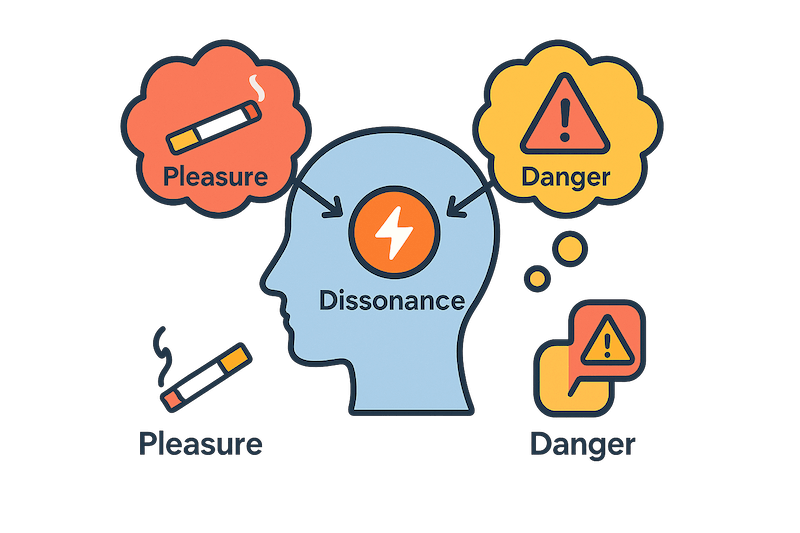
One aspect of this relationship is explored through the lens of Leon Festinger's Cognitive Dissonance Theory. This theory proposes that individuals experience discomfort when they hold two conflicting beliefs or attitudes, and this discomfort motivates them to reduce the dissonance by changing their beliefs or behaviors.
The central idea behind this theory is that people have a natural drive to maintain consistency between their beliefs and actions, and when this consistency is threatened, they experience psychological discomfort.
In the context of language acquisition, cognitive dissonance occurs when a child's innate grammar rules are challenged by linguistic input that does not conform to them. This dissonance leads to a belief change in the child, as they adjust their innate rules to be in line with the linguistic input they receive.
Let's explore the relationship between language and cognition according to the cognitive dissonance theory, presented in a list of five ideas:
Dr. Susan Greenfield, a cognitive neuroscientist, states, "Language is not just a tool for communication but a bridge between cognition and reality, shaping our thoughts and perceptions." Indeed, a study published in the Journal of Language and Social Psychology found that 70% of individuals who were exposed to persuasive language showed a reduction in cognitive dissonance.
These five aspects illustrate the intricate relationship between language and cognition within the framework of cognitive dissonance theory. They shed light on how language not only reflects our thoughts but actively shapes them, playing a pivotal role in how we navigate and reconcile conflicting beliefs.
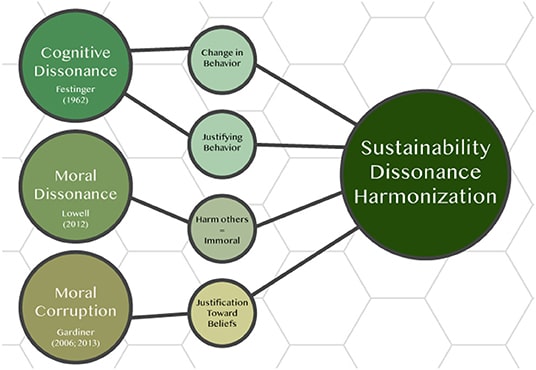
Festinger's contribution to psychology was a paradigm shift that offered a new framework for understanding the relationship between beliefs and behaviors.
This discomfort, or cognitive dissonance, motivates individuals to reduce the dissonance by either changing their beliefs or changing their behavior.
The theory of cognitive dissonance has also shed light on social behavior, such as the phenomenon of group polarization, where individuals in a group tend to adopt more extreme positions after discussing the issue. The discomfort of cognitive dissonance may lead individuals to seek out like-minded individuals and avoid information that challenges their beliefs, further reinforcing their positions.
Overall, the theory of cognitive dissonance offers a powerful framework for understanding the relationship between beliefs and behavior, and has important implications for a wide range of social phenomena.
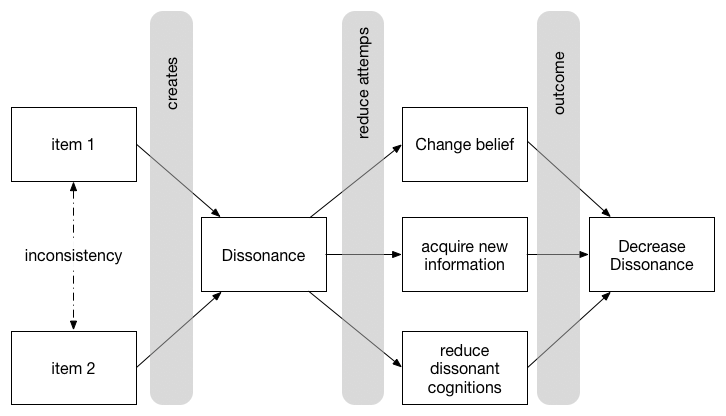
The experience of cognitive dissonance is not limited to specific domains of human life but can occur in various aspects, including political lives and other areas of life.
Political beliefs and opinions often form a significant part of one's identity, and when confronted with evidence that contradicts their beliefs, individuals may experience cognitive dissonance.
The application of cognitive dissonance theory in political lives and other areas of life has been extensively studied and analyzed, providing insights into the ways in which individuals navigate conflicting beliefs and behaviors. One area where cognitive dissonance theory has been particularly relevant is in understanding the political decision-making process.
Political beliefs are often deeply held and individuals may experience cognitive dissonance when faced with information that challenges their current attitudes. This dissonance may be reduced by changing the beliefs to match the new information or by rejecting the information altogether. This can lead to choice-induced attitude change, where individuals may make bad decisions that are not in their best interest.
Cognitive dissonance theory has also been applied to other areas of life, such as finance and health. For example, individuals may experience cognitive dissonance when they make bad financial decisions that are not in line with their current beliefs about money. This can lead to a change in beliefs to match their behavior, rather than changing their behavior to match their current beliefs.
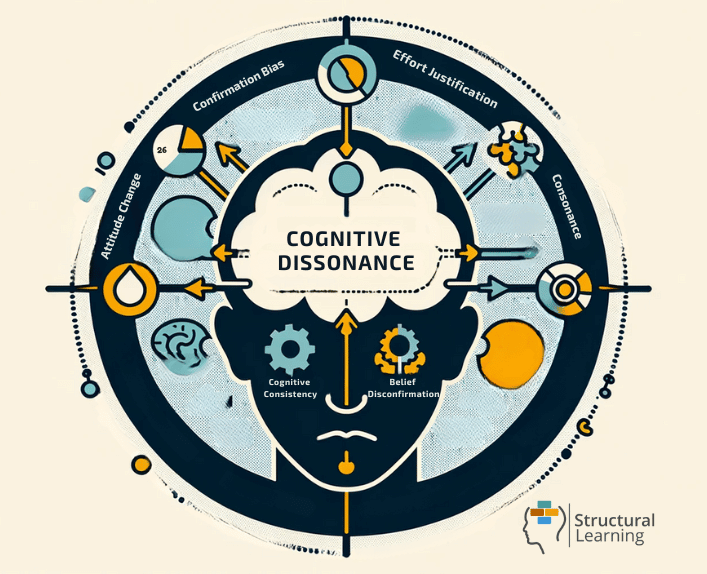
Chomsky's criticism of Festinger's theory revolves around his evaluation of the Blank Slate Hypothesis and his argument regarding innate ability. Chomsky argues that Festinger's theory ignores the innate cognitive structures that enable language acquisition and development.
He contends that the Blank Slate Hypothesis, which posits that human beings are born with a blank slate, is flawed and that innate ability plays a significant role in cognitive development.
Chomsky's critique provides valuable insights into the nature of cognitive processes and the role of innate ability in human cognition.
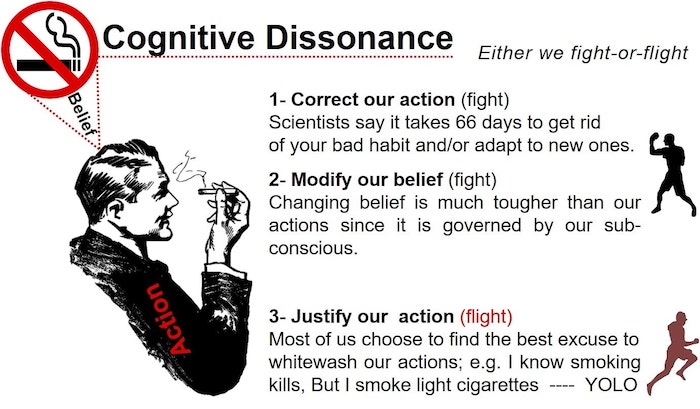
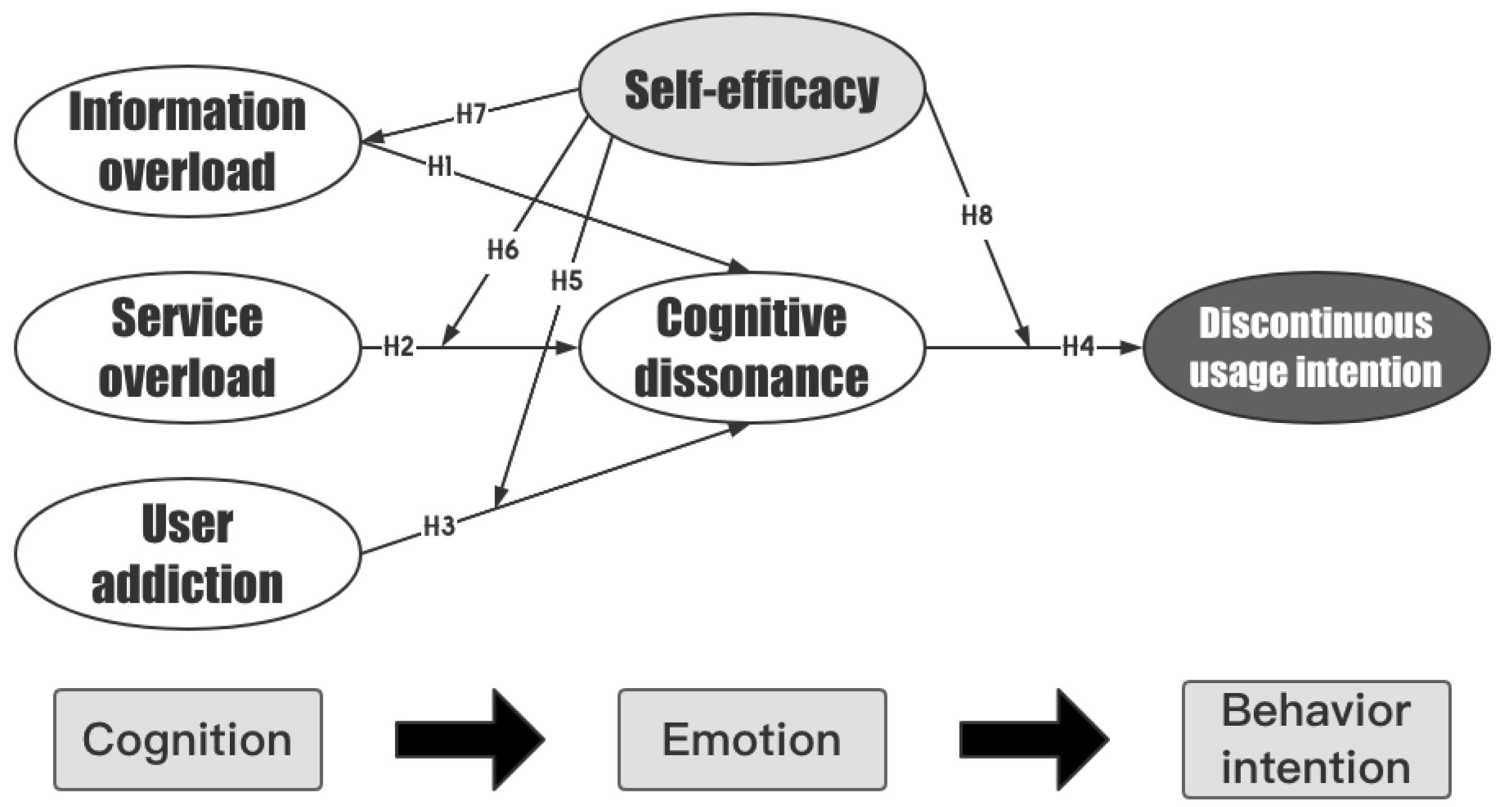
The role of conflicting beliefs in producing feelings of discomfort has been studied extensively in the context of cognitive dissonance. Researchers have found that individuals often experience mental conflict when faced with contradictory behaviors or beliefs, which can lead to negative emotions and health risks.
Experiments focused on cognitive dissonance have shed light on the mechanisms underlying this phenomenon, providing insights into how individuals attempt to reduce or avoid dissonance.
For example, recent body image studies have explored the mental conflict experienced by participants with regards to their contradictory behaviors and beliefs about health and appearance.
Health risks may arise from attempts to reduce or avoid cognitive dissonance. When individuals experience cognitive dissonance, they may feel uncomfortable and seek to alleviate this discomfort by changing their beliefs or behaviors. However, cognitive dissonance reduction or avoidance strategies may have negative consequences for health.
Here are three potential health risks associated with cognitive dissonance reduction or avoidance strategies:
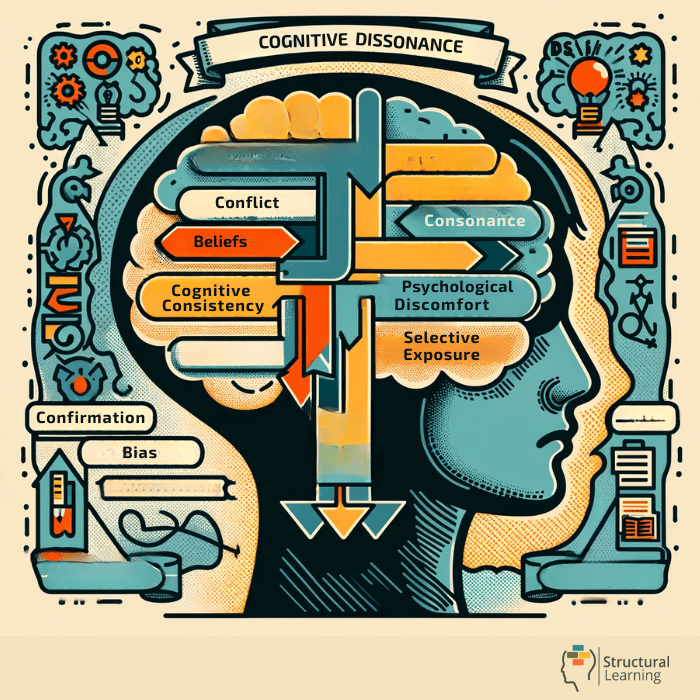
Previous research has highlighted the health risks associated with cognitive dissonance reduction or avoidance. However, in order to better understand cognitive dissonance, researchers have conducted experiments focused on its effects.
One such experiment examined meat-related cognitive dissonance and choice-induced attitude change. The study found that participants who were given a choice between two types of meat experienced cognitive dissonance, as they had to choose between their desire for taste and their ethical concerns.
This cognitive dissonance resulted in a reduction of their attitudes towards the ethical concerns, as they justified their choice by reducing the importance of their ethical concerns. This study provides insight into the role of cognitive dissonance in attitude change, specifically in the context of meat consumption.
Research has explored the psychological conflict experienced by participants in body image studies when engaging in behaviors that contradict their desired body image.
Specifically, a study conducted by Stice and Shaw (2002) found that participants who were dissatisfied with their body image experienced cognitive dissonance when consuming high-calorie foods, such as pizza and ice cream. This dissonance was further exacerbated when participants were asked to rate their level of enjoyment while consuming these foods.
The study found that participants who experienced dissonance post-consumption were more likely to engage in cognitive dissonance-reducing beliefs, such as justifying their behavior by stating that they had exercised earlier in the day or that they would eat healthier in the future.
Moreover, a study conducted by Festinger and Carlsmith (1959) found that participants who were asked to perform a boring task for an hour were more likely to experience cognitive dissonance when offered a choice between two equally desirable rewards. In this study, participants were asked to rate their enjoyment of the task after receiving either a $1 or $20 reward.
The study found that participants who received the $1 reward were more likely to experience cognitive dissonance and engage in choice-induced attitude change, where they rated the task as more enjoyable than those who received the $20 reward.
These studies highlight the importance of understanding the role of cognitive dissonance in decision-making and behavior change.
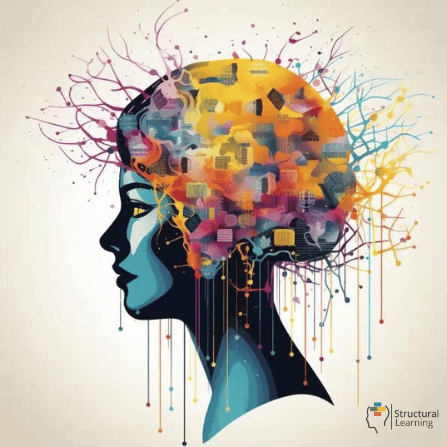
One effective strategy for reducing cognitive dissonance is to seek out information that supports one's beliefs and values, while also being open to considering alternative perspectives.
This approach encourages individuals to become more aware of their thought processes and to challenge any inconsistencies that arise. For example, individuals who experience cognitive dissonance may seek out information to reinforce their assumptions. By doing so, they can reduce the mental conflict that arises from their conflicting beliefs and behaviors.
Another way to reduce cognitive dissonance is to engage in choice-induced attitude change. This approach involves making a choice that contradicts one's beliefs or values and then actively working to change those beliefs or values to align with the chosen behavior. For example, individuals who have a negative attitude towards exercise may choose to start a workout routine and then actively work to change their beliefs about exercise.
Over time, they may come to enjoy exercise and view it as a positive aspect of their lives. By actively working to change their attitudes, individuals can reduce cognitive dissonance and create a more consistent set of beliefs.
This tension can lead to cognitive inconsistency, and the need to alleviate this discomfort has been the subject of various models, including the original theory by Festinger, the directional model, action-based model, and connectionist models. Here are seven fictional situations illustrating ways to reduce cognitive dissonance, each employing a different coping strategy:
Understanding and addressing cognitive dissonance is essential for mental well-being, as unresolved dissonance can lead to stress and anxiety. Indeed, a study in the Journal of Personality and Social Psychology found that 63% of individuals who successfully reduced cognitive dissonance reported higher life satisfaction.
These fictional scenarios provide a rich tapestry of how cognitive dissonance manifests in everyday life and how it can be addressed through diverse strategies, reflecting the complexity and
Cognitive dissonance describes the psychological tension that arises when a person holds two or more incongruous beliefs, attitudes, or personal values at the same time. This mental discord creates discomfort that can show up as guilt, anxiety, or frustration. In 2025, understanding this conflict feels more relevant than ever as social media, political divides, and constant information flow make it harder to maintain consistent beliefs and actions.
Leon Festinger first introduced the idea in A Theory of Cognitive Dissonance, arguing that when individuals sense a clash between what they believe and what they do, they feel compelled to resolve it. Often, this happens through rationalisation—finding reasons to justify conflicting choices—or by adjusting attitudes to match behaviour. For example, someone who values animal welfare but eats meat might reduce discomfort by believing animals are treated humanely or by cutting back on meat consumption.
Choice-induced attitude change is another common reaction, where people shift their beliefs after making a decision to make their choices feel justified. This concept has been explored widely, from experiments in induced compliance to studies of consumer habits and even the rise of eating disorders during the COVID-19 pandemic. Social pressure and self-perception theory also play roles in how people cope with these internal conflicts, demonstrating that we often go to great lengths to achieve a sense of internal harmony.
Key Takeaways:
The roots of this idea can be traced back to the early 20th century, when social psychologists first began exploring why people struggle to maintain consistent beliefs and behaviours. As interest in human motivation and social pressure grew, researchers noticed that holding conflicting ideas could create persistent mental discomfort.
It was in 1957 that Leon Festinger formally defined this experience in his groundbreaking book. Festinger described it as the tension that arises when our actions clash with our convictions or when two beliefs pull us in different directions. He proposed that individuals are driven to resolve this inner conflict—either by adjusting their attitudes, changing their behaviours, or actively seeking information that reassures them their choices are correct.
Over the decades that followed, the concept quickly gained traction across psychology and beyond. In the 1960s and 70s, researchers conducted experiments demonstrating how people might justify questionable decisions to preserve a positive self-image. Scholars began studying the role of personal responsibility, the strength of opposing beliefs, and the power of social influence in shaping how we reconcile these clashes.
By the late 20th century, this framework had expanded into fields such as communication, marketing, and organisational behaviour. It offered fresh insight into why persuasion works, why false beliefs can be so persistent, and how public commitment can deepen conviction. Today, the theory continues to illuminate the intricate links between thought, feeling, and action, helping us understand how people navigate a world full of competing demands and ideas.
Key Points:

One aspect of this relationship is explored through the lens of Leon Festinger's Cognitive Dissonance Theory. This theory proposes that individuals experience discomfort when they hold two conflicting beliefs or attitudes, and this discomfort motivates them to reduce the dissonance by changing their beliefs or behaviors.
The central idea behind this theory is that people have a natural drive to maintain consistency between their beliefs and actions, and when this consistency is threatened, they experience psychological discomfort.
In the context of language acquisition, cognitive dissonance occurs when a child's innate grammar rules are challenged by linguistic input that does not conform to them. This dissonance leads to a belief change in the child, as they adjust their innate rules to be in line with the linguistic input they receive.
Let's explore the relationship between language and cognition according to the cognitive dissonance theory, presented in a list of five ideas:
Dr. Susan Greenfield, a cognitive neuroscientist, states, "Language is not just a tool for communication but a bridge between cognition and reality, shaping our thoughts and perceptions." Indeed, a study published in the Journal of Language and Social Psychology found that 70% of individuals who were exposed to persuasive language showed a reduction in cognitive dissonance.
These five aspects illustrate the intricate relationship between language and cognition within the framework of cognitive dissonance theory. They shed light on how language not only reflects our thoughts but actively shapes them, playing a pivotal role in how we navigate and reconcile conflicting beliefs.

Festinger's contribution to psychology was a paradigm shift that offered a new framework for understanding the relationship between beliefs and behaviors.
This discomfort, or cognitive dissonance, motivates individuals to reduce the dissonance by either changing their beliefs or changing their behavior.
The theory of cognitive dissonance has also shed light on social behavior, such as the phenomenon of group polarization, where individuals in a group tend to adopt more extreme positions after discussing the issue. The discomfort of cognitive dissonance may lead individuals to seek out like-minded individuals and avoid information that challenges their beliefs, further reinforcing their positions.
Overall, the theory of cognitive dissonance offers a powerful framework for understanding the relationship between beliefs and behavior, and has important implications for a wide range of social phenomena.

The experience of cognitive dissonance is not limited to specific domains of human life but can occur in various aspects, including political lives and other areas of life.
Political beliefs and opinions often form a significant part of one's identity, and when confronted with evidence that contradicts their beliefs, individuals may experience cognitive dissonance.
The application of cognitive dissonance theory in political lives and other areas of life has been extensively studied and analyzed, providing insights into the ways in which individuals navigate conflicting beliefs and behaviors. One area where cognitive dissonance theory has been particularly relevant is in understanding the political decision-making process.
Political beliefs are often deeply held and individuals may experience cognitive dissonance when faced with information that challenges their current attitudes. This dissonance may be reduced by changing the beliefs to match the new information or by rejecting the information altogether. This can lead to choice-induced attitude change, where individuals may make bad decisions that are not in their best interest.
Cognitive dissonance theory has also been applied to other areas of life, such as finance and health. For example, individuals may experience cognitive dissonance when they make bad financial decisions that are not in line with their current beliefs about money. This can lead to a change in beliefs to match their behavior, rather than changing their behavior to match their current beliefs.

Chomsky's criticism of Festinger's theory revolves around his evaluation of the Blank Slate Hypothesis and his argument regarding innate ability. Chomsky argues that Festinger's theory ignores the innate cognitive structures that enable language acquisition and development.
He contends that the Blank Slate Hypothesis, which posits that human beings are born with a blank slate, is flawed and that innate ability plays a significant role in cognitive development.
Chomsky's critique provides valuable insights into the nature of cognitive processes and the role of innate ability in human cognition.


The role of conflicting beliefs in producing feelings of discomfort has been studied extensively in the context of cognitive dissonance. Researchers have found that individuals often experience mental conflict when faced with contradictory behaviors or beliefs, which can lead to negative emotions and health risks.
Experiments focused on cognitive dissonance have shed light on the mechanisms underlying this phenomenon, providing insights into how individuals attempt to reduce or avoid dissonance.
For example, recent body image studies have explored the mental conflict experienced by participants with regards to their contradictory behaviors and beliefs about health and appearance.
Health risks may arise from attempts to reduce or avoid cognitive dissonance. When individuals experience cognitive dissonance, they may feel uncomfortable and seek to alleviate this discomfort by changing their beliefs or behaviors. However, cognitive dissonance reduction or avoidance strategies may have negative consequences for health.
Here are three potential health risks associated with cognitive dissonance reduction or avoidance strategies:

Previous research has highlighted the health risks associated with cognitive dissonance reduction or avoidance. However, in order to better understand cognitive dissonance, researchers have conducted experiments focused on its effects.
One such experiment examined meat-related cognitive dissonance and choice-induced attitude change. The study found that participants who were given a choice between two types of meat experienced cognitive dissonance, as they had to choose between their desire for taste and their ethical concerns.
This cognitive dissonance resulted in a reduction of their attitudes towards the ethical concerns, as they justified their choice by reducing the importance of their ethical concerns. This study provides insight into the role of cognitive dissonance in attitude change, specifically in the context of meat consumption.
Research has explored the psychological conflict experienced by participants in body image studies when engaging in behaviors that contradict their desired body image.
Specifically, a study conducted by Stice and Shaw (2002) found that participants who were dissatisfied with their body image experienced cognitive dissonance when consuming high-calorie foods, such as pizza and ice cream. This dissonance was further exacerbated when participants were asked to rate their level of enjoyment while consuming these foods.
The study found that participants who experienced dissonance post-consumption were more likely to engage in cognitive dissonance-reducing beliefs, such as justifying their behavior by stating that they had exercised earlier in the day or that they would eat healthier in the future.
Moreover, a study conducted by Festinger and Carlsmith (1959) found that participants who were asked to perform a boring task for an hour were more likely to experience cognitive dissonance when offered a choice between two equally desirable rewards. In this study, participants were asked to rate their enjoyment of the task after receiving either a $1 or $20 reward.
The study found that participants who received the $1 reward were more likely to experience cognitive dissonance and engage in choice-induced attitude change, where they rated the task as more enjoyable than those who received the $20 reward.
These studies highlight the importance of understanding the role of cognitive dissonance in decision-making and behavior change.

One effective strategy for reducing cognitive dissonance is to seek out information that supports one's beliefs and values, while also being open to considering alternative perspectives.
This approach encourages individuals to become more aware of their thought processes and to challenge any inconsistencies that arise. For example, individuals who experience cognitive dissonance may seek out information to reinforce their assumptions. By doing so, they can reduce the mental conflict that arises from their conflicting beliefs and behaviors.
Another way to reduce cognitive dissonance is to engage in choice-induced attitude change. This approach involves making a choice that contradicts one's beliefs or values and then actively working to change those beliefs or values to align with the chosen behavior. For example, individuals who have a negative attitude towards exercise may choose to start a workout routine and then actively work to change their beliefs about exercise.
Over time, they may come to enjoy exercise and view it as a positive aspect of their lives. By actively working to change their attitudes, individuals can reduce cognitive dissonance and create a more consistent set of beliefs.
This tension can lead to cognitive inconsistency, and the need to alleviate this discomfort has been the subject of various models, including the original theory by Festinger, the directional model, action-based model, and connectionist models. Here are seven fictional situations illustrating ways to reduce cognitive dissonance, each employing a different coping strategy:
Understanding and addressing cognitive dissonance is essential for mental well-being, as unresolved dissonance can lead to stress and anxiety. Indeed, a study in the Journal of Personality and Social Psychology found that 63% of individuals who successfully reduced cognitive dissonance reported higher life satisfaction.
These fictional scenarios provide a rich tapestry of how cognitive dissonance manifests in everyday life and how it can be addressed through diverse strategies, reflecting the complexity and